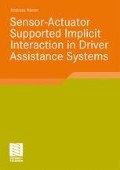Abstract
The number (particularly that of non-driving tasks) and the complexity of activities inside the car – as shown in Fig. 8.1 – has risen constantly in the last years. One possible consequence of this development is an increase in driver distraction [99] which needs to be avoided or compensated as much as possible in order to ensure safe and accident-free vehicle control. A second issue is that most of the vehicular systems (see righthand side of Fig. 8.1) deliver feedback on the car's status (which cannot be switched off) to the driving person and thus, lead to information overload and driver distraction.
Access this chapter
Tax calculation will be finalised at checkout
Purchases are for personal use only
Preview
Unable to display preview. Download preview PDF.
Rights and permissions
Copyright information
© 2010 Vieweg+Teubner | GWV Fachverlage GmbH
About this chapter
Cite this chapter
Riener, A. (2010). Driver Activity and Notification Demands. In: Sensor-Actuator Supported Implicit Interaction in Driver Assistance Systems. Vieweg+Teubner. https://doi.org/10.1007/978-3-8348-9777-0_8
Download citation
DOI: https://doi.org/10.1007/978-3-8348-9777-0_8
Publisher Name: Vieweg+Teubner
Print ISBN: 978-3-8348-0963-6
Online ISBN: 978-3-8348-9777-0
eBook Packages: EngineeringEngineering (R0)

